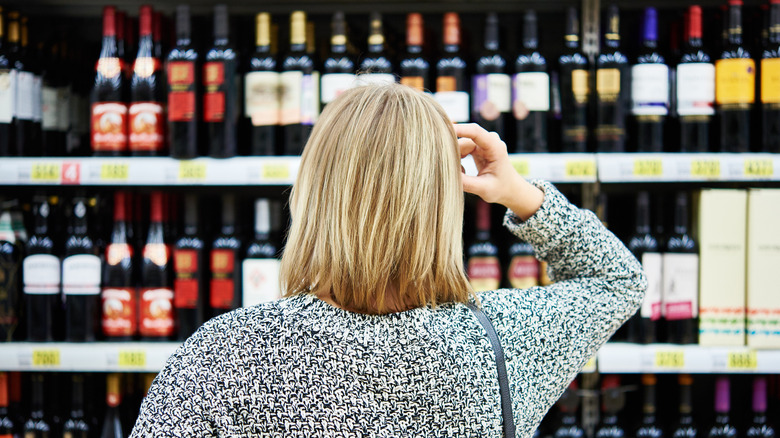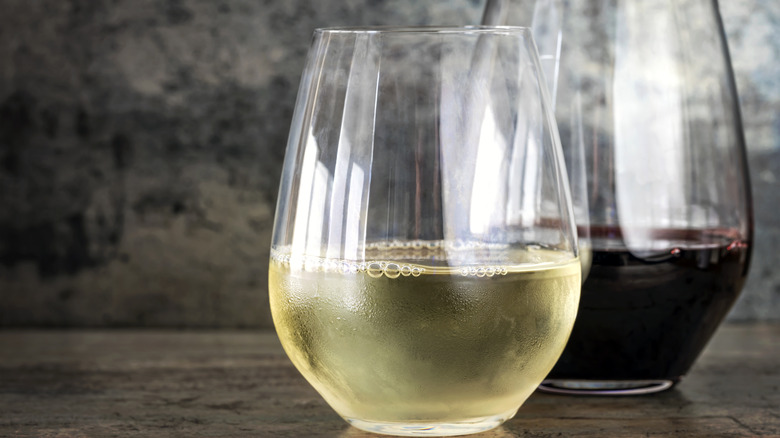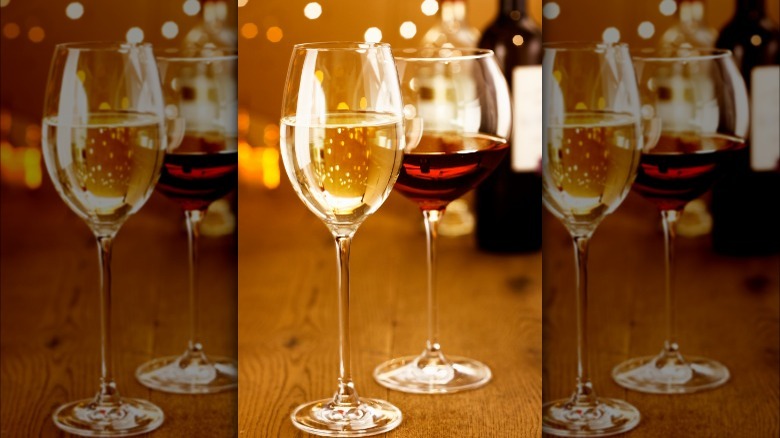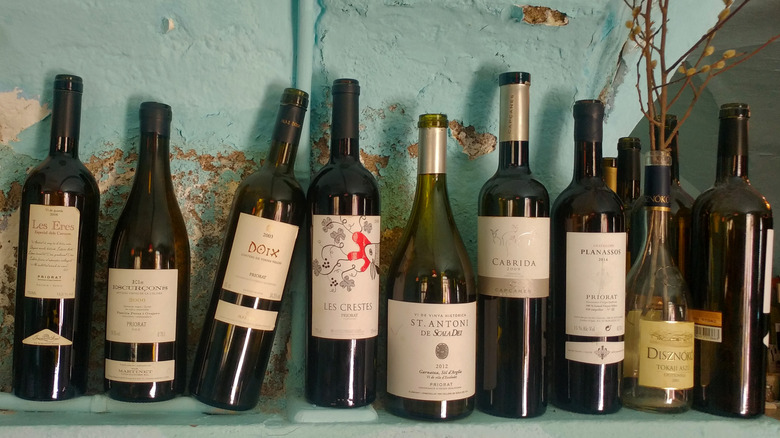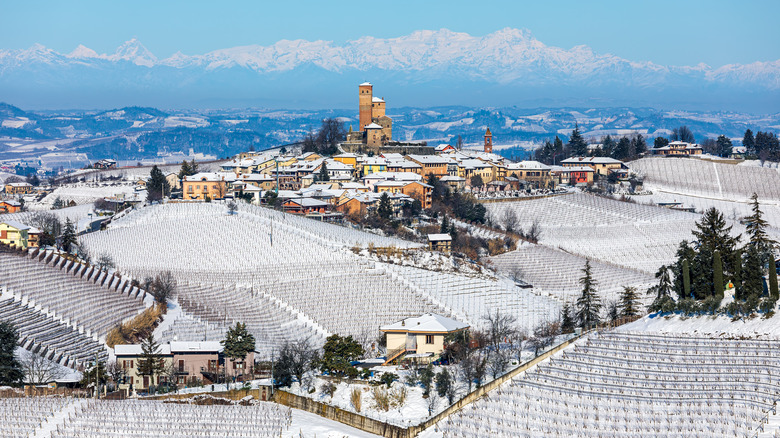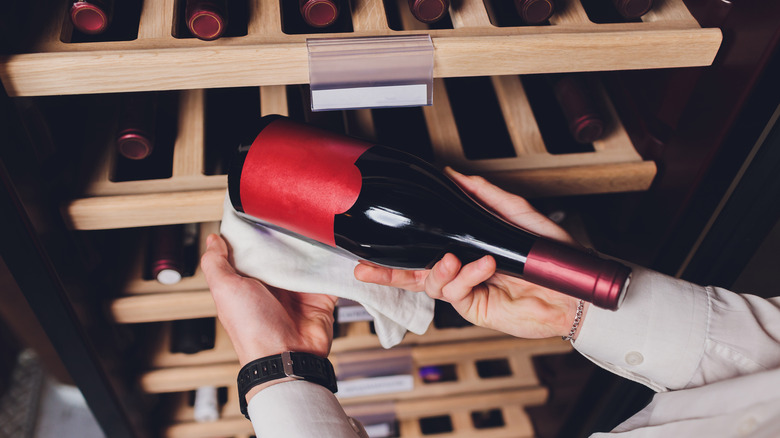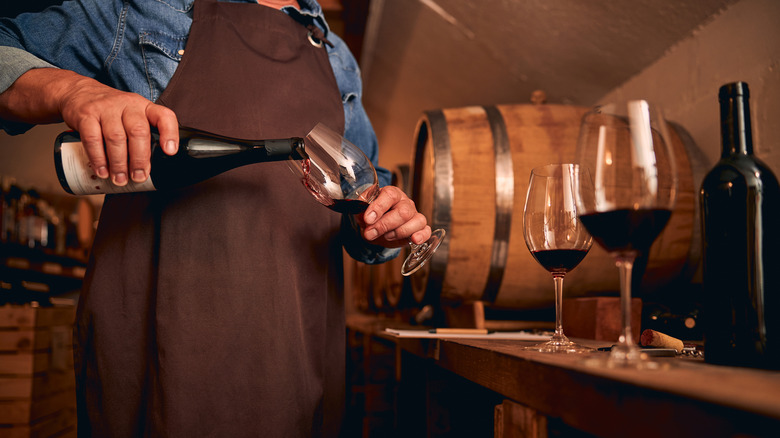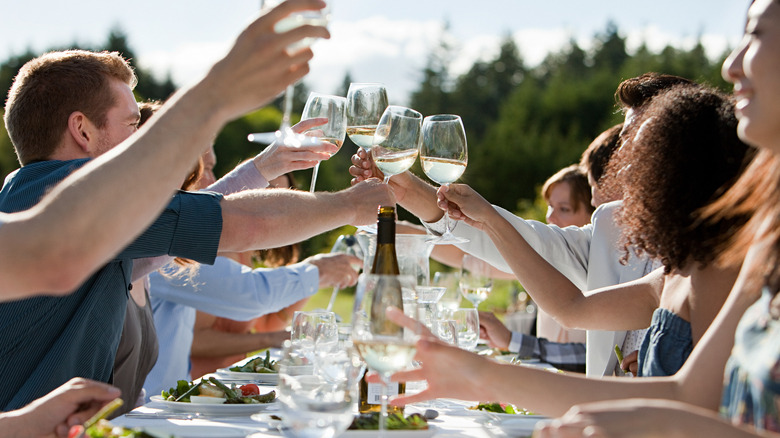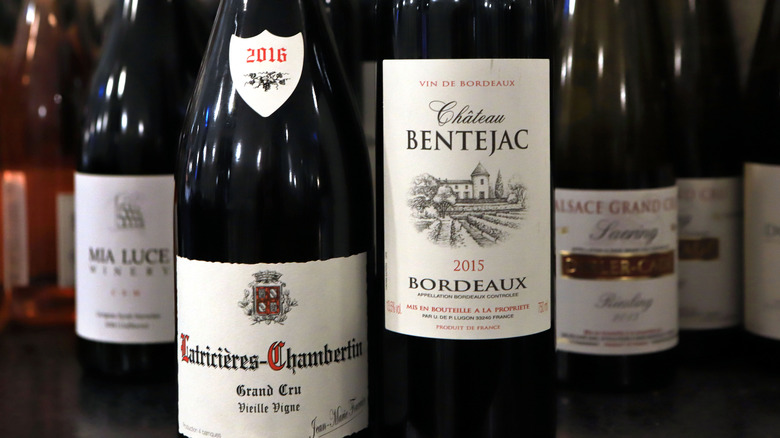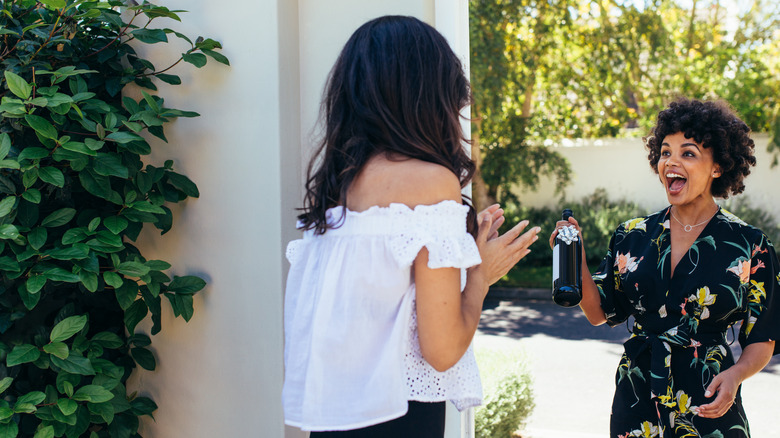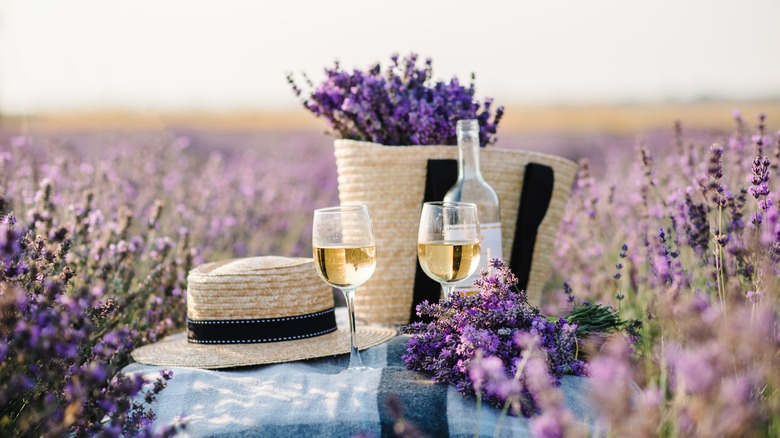14 Questions You Should Always Ask When Buying Wine
Stopping by your local wine shop or big box liquor store to pick up a bottle can be a tricky task. While you may be the kind of person who can waltz in and grab the first bottle with an enticing label, this method isn't entirely foolproof. Nor does it give you much of a say as to what kind of wine you'll end up sipping. Granted, considering the vast range of options in the average store, it's often the simplest solution.
Thankfully, you don't need to study for years and become a Master Sommelier to make educated wine purchases. It's all about planning; if you go into the shop with a few basic elements in mind, you can vastly improve your chances of success. To further streamline the decision-making process, we've put together a list of key questions to ask yourself (and potentially the sales clerk) in order to pick a bottle (or a case) that will satisfy your taste and purpose. Best of all, asking these questions might even lead you to find wines that offer the characteristics you're looking for at a better value.
1. Red or white?
It might seem basic, but a great place to start is determining whether you want to drink red or white wine. Your decision can be guided by the food you're planning to serve, the weather outside, personal preference, or your mood. While it isn't the case across the board, Usual Wines points out that white wine tends to have more citrusy notes, whereas red wines have more of a berry profile. You may immediately feel your palate veering toward one or the other.
Food pairings that restrict white wine to seafood and red wine to meat are outdated, and picking something you enjoy will lead to a better experience than simply choosing an arbitrary match. Still, if you have no clue what bottle to go with, choosing one that offers a complementary or contrasting pairing to a particular dish is a straightforward option.
A hot sunny day calls for a crisp refreshing white wine, whereas cold and rainy weather might draw you to a deep and complex bottle of red wine. Of course, if neither category is quite doing it, rosé and skin-contact (orange) wine provide an interesting option along the spectrum.
The former typically displays a bright freshness that pairs well with food while being an excellent choice for sipping on a hot patio. Meanwhile, orange wines have more structure and tannins than white wine, which makes them a versatile food pairing without being as weighty as a bottle of red.
2. Sparkling or still?
Many wine drinkers limit sparkling wine to special occasions, but there really isn't a reason to leave it out of your repertoire. Sure, it gets pricey fast if you're buying Champagne every week, but there are many more affordable alternatives to satisfy a desire for bubbly. Considering the vast difference in mouthfeel between still and sparkling wine, it's also an effective way to narrow down your selection.
Choosing between these categories is a no-brainer for some people but not so much for others. If you sit in the second camp, start by determining the occasion. Is it just an ordinary weeknight dinner? Are you planning to invite guests over, or are you celebrating? Are you looking to liven up a moment?
Popping open a bottle of bubbly can really shake up a simple meal at home. If you're selecting a wine to serve as an aperitif, sparkling tends to be a crowd-pleaser that goes down easily without the need for food (though salty snacks or cheese make an excellent accompaniment).
If you want to highlight a dish with a food pairing, you may have better luck with still wine, choosing to play with the color, body, tannin, and acidity level instead. Additionally, small details such as whether you can keep the wine refrigerated could push you to opt for a fuss-free option. In this case, In this case, a still red wine is more resilient, and a warm bottle of bubbly doesn't quite have the same allure.
3. Familiar or adventurous?
It's normal to stick with something you like, especially if it has taken you time to zoom in on your preferences. There's nothing wrong with making a beeline for the same bottle every time you walk into the wine store — as long as you're guided by your love for that wine rather than complete despair at the thought of trying to find another bottle you'll enjoy.
On the other hand, if you feel it's time to drift into uncharted territories, there are endless ways to experiment. If you want to start by taking baby steps, choose a grape variety you enjoy and consider trying a version from a completely new region. This might take some research or require assistance from a sales clerk, as not all bottles are labeled with the grape variety. Typically, wines from Europe will indicate a region, whereas those from other countries will highlight the grape (of course, there are exceptions).
Another option is to simply opt for a bottle from a wine region you know nothing about. If it's a small area with traditional winemaking practices, it's likely that you'll know just as little about the grape variety. The fastest way to discover what's out there is by tasting wines that are completely out of your current repertoire. If you want to up your chances of actually enjoying your selection, ask your sales clerk (or Google) for something similar to a region or grape you like or with specific features you enjoy.
4. New world or old world?
The more you dive into wine, the more you'll start to discover the countless ways in which it can be classified. A regional and stylistic approach to categorizing wine separates it into the old and new worlds. Generally, old world consists of anywhere in Europe and the Middle East, and the new world encompasses the rest (via VinePair).
The basis for the distinction is that the old world is the birthplace of wine, where grape varieties were first grown, and winemaking practices initially developed. Producers in these areas are often held to regional standards of viticulture and winemaking, creating a certain expectation for consumers.
On the other hand, the new world includes regions that were influenced by old world countries, often due to immigration or colonization. Experimentation, technology, and novelty are often at the forefront, resulting in a wide range of options for wine drinkers.
The division can be made on a geographical level, but it also extends to wine styles. Old world regions commonly experience cooler growing conditions, which affects the way grapes ripen. In turn, this plays a role in sugar levels, flavor, and alcohol content.
Broadly speaking, old world wines are lighter-bodied and lower in alcohol, while new world wines showcase fruitier aromas, a bigger body, and more alcohol. There are many exceptions on both ends but these labels can eliminate some bottles from a large selection.
5. Cool climate or warm climate?
When you're stuck with no direction to your purchase, choosing between cool and warm climate wines is one way to break it down further. You might not have given much thought to the actual vineyard where the grapes in your bottle of wine are grown, but knowing some of the specifics can give you a better idea of the final product.
If you stop to think about grapes as being just like any other fruit, consider the difference between the flavor of a ripe peach and one that's still a bit green. The former will be brimming with juiciness, rich with layered flavors of jammy fruit and summertime. The latter will be acidic, not so juicy, and display a bright aromatic profile.
More sunshine and heat means the fruit has more time to ripen and build up sugars, ultimately resulting in fruitier flavors and higher alcohol content. Meanwhile, fruit grown in cool climates will retain greater acidity, which translates to a crisper zingier wine.
Both styles can be delicious as long as they are balanced, but they are quite distinct. If you want to taste for yourself, pick up a bottle of chardonnay from Napa and one from Chablis in Northern France. Not only will you observe the difference between a warm and cool climate, but you'll be able to taste new world and old world versions of the same grape.
6. Good deal or splurge?
It's natural to have days when you want to splash out on a special bottle, whereas finding the best value is your MO at another moment. According to the results of a recent survey of 1,000 wine professionals, the new "sweet spot" for consumers is $21 for a bottle (via Market Watch). That being said, about a third of retail sales consist of bottles priced between $5 and $10 (via BinWise).
Logically, a bottle of wine that costs under $10 probably isn't made with hand-harvested grapes from the best vineyards in a famous region. As Elizabeth Schneider of Wine for Normal People explains, the grapes, which are the foundation of wine, are probably not at peak quality in this price range.
As for the winemaking process, it requires close attention to detail in order to find an ideal balance. Again, the less money you're spending, the greater chance these steps are being done with less care and input from a winemaker. Meanwhile, factors such as marketing, organic certifications, and small-scale production can all impact the price of a bottle.
It's totally fair to spend $10 one week and $60 the following. However, considering that the actual number has a significant influence on the options you'll be choosing from, it helps to go into the store with a general idea of how much you want to spend. It would be great if there was a clear relationship between quality and cost, but it isn't a consistent measure.
7. Large producer or small-scale winery?
The source of your wine may not be the first aspect you consider, but if you want to increase your chances of choosing a bottle you enjoy, narrowing down on reputable producers is a good option. Just as one person may have no problem popping into a fast-food chain while another only eats at farm-to-table restaurants, the same values come to play with wine producers.
Large recognizable wineries grace most store shelves with logos that are as much a part of the consumer repertoire as popular beer or soda brands. Meanwhile, small-scale producers reflect a more artisanal approach and are often only available in select shops. Choosing the latter requires a leap of faith or a bit of research prior to shopping. It's normal to be more inclined to reach for the familiar-looking wine label, but bottles from smaller producers can be a welcome surprise.
As The Guardian reports, many marketing buzzwords are intended to give the illusion of small production. While the specific size of the vineyard is up for debate, the idea that fewer people focused on smaller plots can place more attention on a product than a giant winery with thousands of hectares scattered around a vast area of land is hard to dispute.
And, of course, considering the budgets backing larger corporations, if you're looking for a good deal, it may very well come from these sources. Not to mention, the scale of production and reputation generally help guarantee consistency.
8. Natural or conventional?
If you're purchasing wine in stores, chances are you've begun to see more labels indicating natural, organic, or low-intervention wines. Much like one customer shops for organic fruit at the farmers' market and another gets their produce at Costco, natural and conventional wines display a similar dichotomy.
Perhaps you're explicitly seeking out natural styles in an effort to make a conscious decision about how your wine is made. Or maybe the flashy labels of artisanal wines beckon you. No matter the reason, an increasing number of consumers are choosing to pay attention to the process behind the product (via BevAlcInsights).
While there are many reasons to choose natural wine, it often comes with a heftier price tag, given that production is typically more organic and can require more attention in the cellar. Conventional wines from reputable producers shouldn't be dismissed, though.
They offer good access for wine drinkers, often with recognizable logos and consistent products year after year. That being said, some consumers are not on board with certain food additives in wine permitted by the U.S. Food & Drug Administration. Both options are completely acceptable, but if you are firmly opinionated in either direction, that will help you with your selection.
9. Celebratory or everyday drinking?
While it's great to bust out a bottle of bubbly on a regular night to add some pep to your routine. However, champagne can be expensive, and most people can't afford to splurge on every bottle of wine they buy. When you're making a selection at the wine shop, the cost is certainly a factor, but it isn't the only element that distinguishes between celebratory wines and those that are meant for everyday drinking.
Of course, bubbles tend to be considered festive across the board, which makes them an easy pick if you are indeed celebrating. The bottle doesn't have to be expensive either: Spanish Cava and French Crémant are both made following the same method of fermentation as Champagne and regularly sell at a fraction of the price.
If you have a special anniversary or birthday on the agenda, choosing a vintage bottle is a good option. Or perhaps you've been pining over a certain region or producer and want to pick up a bottle for an occasion.
Considering that you probably have more everyday occasions to drink wine than celebratory ones, it's still worth finding nice bottles you enjoy. In these cases, your source of inspiration could be the food you're cooking, your current mood, your curiosity, or simply something the sales clerk recommends as being of good value.
10. To serve with food or sip solo?
Wine and food pairings receive a vast amount of attention, partly because of their accessibility. The average consumer may not know anything about first-growth Bordeaux but will gladly dive into the details about pairing wine with their salmon dinner. Food is fundamental to wine for many people, so it makes sense to use it as a springboard for your selection process.
There's no need to be too dogmatic about specific food pairings, but if you're looking for a streamlined dining experience, it's worthwhile to note a few key points. Pairings can be complementary and highlight similar features, or they can contrast to provide a palate cleanser. Also, choosing wines with a similar weight and intensity to the dish you're serving will prevent either one from overpowering the other.
Of course, plenty of occasions call for a solo glass of wine, whether you're sitting on a sunny patio or sipping as you prepare dinner. In these cases, a lighter-bodied wine may be more palatable. Similarly, lower tannin options are a good way to avoid excess astringency when there's no food to counteract it. If you're not sure whether food will be involved, sparkling wine is always a good bet.
11. Single-varietal or blend?
It's certainly easier to keep the name of several common grape varieties in mind rather than to know the various blends of famous wine regions. (Especially when some places like Chateauneuf-du-Pape allow over a dozen grapes in a blend.) Unless the grape variety is written front and center on the bottle label, you might not even know that the red Burgundy you're sipping on is pinot noir. Similarly, a red Bordeaux blend can contain any combination of cabernet sauvignon, merlot, cabernet franc, malbec, and petit verdot grapes.
There's also the fact that many wine regions only require the grape indicated on the label to account for a minimum of 75 to 85 percent of the content of the bottle without having to specify the remaining balance (via NUVO). There's nothing inherently better or worse between wines showcasing a single variety and those featuring a blend.
The former can help you hone in on features you enjoy in a particular grape, while the latter highlights the way grapes can harmoniously play off each other's qualities. Indeed, blends are often favored by winemakers seeking balance. If a wine is lacking acidity, tannin, body, or certain flavors, blending it with grapes that display these characteristics can tie everything together. Meanwhile, field blends are made with an assortment of grapes from the same vineyard that are harvested and vinified simultaneously.
12. Who will drink it?
If you are a regular wine drinker, then you're probably mainly choosing bottles for yourself when you go wine shopping. Still, chances are you spend time imbibing with other people too, whether it be family, friends, roommates, or fellow dinner party guests. In these cases, your selection may be guided by more than your own preferences. Not to mention, there are instances where you may want to gift wine.
If you are planning to open a bottle with other people, you'll either have a lot of knowledge about their favorite types of wine or zero information to go by ahead of time. In the latter case, consider choosing a wine based on a food pairing or look for something that has a particular significance for you that can serve as a conversation point. Whether you visited a vineyard, can't get enough of a certain bottle, or have recently discovered a unique grape, these can all serve as inspiration for your selection.
13. What mood are you going for?
The beauty of wine is that, along with the wide range of flavors, it also has the capacity to evoke a mood. The festive effervescence of sparkling wine is an easy example, as it playfully dances in your glass and adds a spark to the evening. Meanwhile, pink wine drinkers are all too eager to enthusiastically express their philosophy of "rosé all day." If you're in the mood for easy sipping, a crisp refreshing white wine may be better suited than a bold tannic red. On the flip side, a complex glass of red wine is the perfect pairing for a crackling fireplace.
Researchers at Michigan State University went a step further and examined Master of Wine Tim Hanni's vinotype theory, which suggests that people fit into one of four categories: Sweet, hypersensitive, sensitive, and tolerant. Depending on where you fall on this spectrum, you'll be more drawn to sweet fruity wines on one end or bold tannic wines at the other extreme. By allowing your mood and personal preferences to dictate your purchases, you'll increase the chances of ending up with something that suits your taste.
14. Are you open to suggestions?
If you have access to a well-stocked wine shop with staff that's in the know, you can gain a lot from acquainting yourself with employees. You don't have to get personal; the goal is to share your wine interests and express what you are open to trying. Whether you want to taste every single New Zealand sauvignon blanc available or are curious about grapes with a similar aromatic profile or from a distant region, a trained wine store clerk will be able to give you advice.
If you find yourself in a rut or always disappointed with your bottle choices, there are no better people to ask than those who know what's on the shelves. While they may not land on the bull's eye with their first recommendation, if the clerk is enthusiastic, confident, and eager to assist, there's a good chance you will be able to develop a sufficient rapport that allows them to figure out your preferred flavor profiles.
Most importantly, share as much about your likes and dislikes as possible (no matter the terminology you use) in order to paint a better picture for them. And, of course, don't hesitate to comment about whether or not you enjoyed a bottle. If you don't have access to that kind of service at your local store, consider doing research online or using wine apps to seek out other opinions that might guide your journey. Finding your personal wine style isn't always a direct path.
